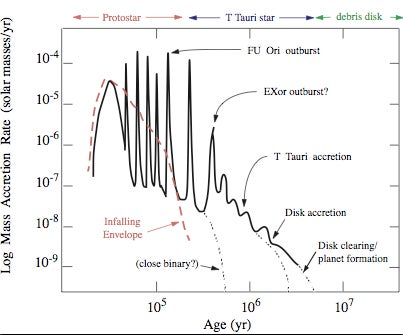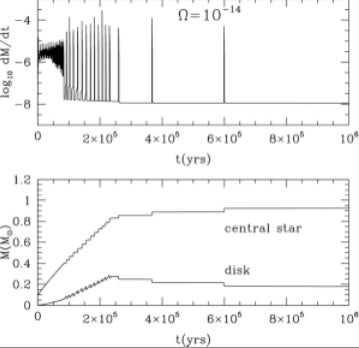Courtesy John Bally & Bo Reipurth
The molecular cloud “cores” from which stars form are of order one million times larger than the ultimate stellar diameter. For this reason, any small amount of angular momentum initially present in the cloud results in collapse to a rotating disk rather than directly to the star, at least for most of the cloud’s mass. The image on the right shows an edge-on disk, seen in scattered light from the upper and lower dusty disk surfaces, with the central protostar hidden behind the dark extinction lane of the disk. On larger scales, scattered light originating at the protostar illuminates a cavity in the otherwise dark infalling envelope, driven at least in part by mass ejection from the inner disk. As shown in the left panel, complex, turbulent outflow cavities are frequently seen, with narrower jets along the outflow axis. These(bipolar) jets are driven by accretion energy, and are probably magnetically accelerated along the rotation axis of the disk,
An edge-on disk in a protostar; research conducted by former graduate student John Tobin, currently professor at the University of Oklahoma

 Because much, if not most, of the mass of a protostellar cloud must land initially on a disk, it follows that disk accretion is an important process in forming stars. This has led to the schematic picture of star formation shown on the left, in which the collapsing envelope feeds mass to the disk during the protostar phase, which lasts at most a few hundred thousand years. There is evidence that accretion through the protostellar disk is not steady, but occurs in bursts of short-lived, very rapid accretion. An example of this type of outburst is given by the FU Ori objects, which can accrete 1% of a solar mass – 10 Jupiter masses – over timescales as short as a century. Our theory to explain these outbursts invokes a combination of gravitational instability, which moves mass in from large disk radii, with the magnetorotational instability, which “turns on” at a given stage and rapidly dumps material onto the central star (see numerical simulation at below left) We predict that the region of high accretion extends out to a few AU during outburst, which is consistent with spectral modeling of FU Ori.
Because much, if not most, of the mass of a protostellar cloud must land initially on a disk, it follows that disk accretion is an important process in forming stars. This has led to the schematic picture of star formation shown on the left, in which the collapsing envelope feeds mass to the disk during the protostar phase, which lasts at most a few hundred thousand years. There is evidence that accretion through the protostellar disk is not steady, but occurs in bursts of short-lived, very rapid accretion. An example of this type of outburst is given by the FU Ori objects, which can accrete 1% of a solar mass – 10 Jupiter masses – over timescales as short as a century. Our theory to explain these outbursts invokes a combination of gravitational instability, which moves mass in from large disk radii, with the magnetorotational instability, which “turns on” at a given stage and rapidly dumps material onto the central star (see numerical simulation at below left) We predict that the region of high accretion extends out to a few AU during outburst, which is consistent with spectral modeling of FU Ori.
The disk left over after stellar accretion has been mostly completed can then be the site of planet formation during the T Tauri phase (for low-mass stars). Eventually a combination of accretion onto the central star, accretion into planetary bodies, and photoevaporation of disk gas “clears” the disk of gas and dust, on timescales of order 10 million years or somewhat less.
Long term evolution of protostellar disks; research conducted by former graduate student Zhaohuan Zhu, currently professor at University of Nevada-Las Vegas



